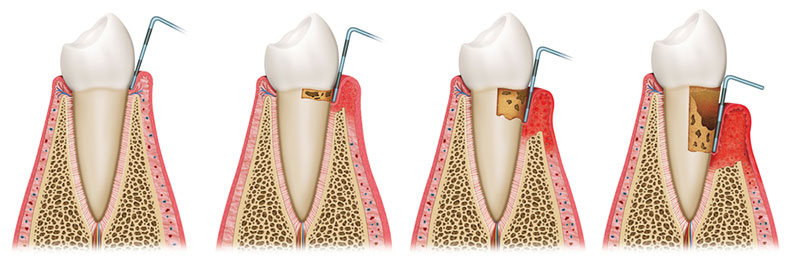Periodontal disease is an inflammatory disease of the gums caused by bacteria that live naturally in your mouth. It causes progressive destruction of the gum and bone around the teeth that can lead to tooth loss over time.
What causes gum disease?
Bacteria live in colonies called plaque which forms on your teeth constantly. Plaque is made up of billions of bacteria in a protective coat. This can be felt as a clear sticky film on the teeth and can make the teeth feel “fuzzy” if it isn’t removed properly twice daily. The plaque is relatively harmless, and is in fact protective, in small quantities, but if left to build into a significant layer, can start to damage your tissues and teeth.
If you do not remove plaque thoroughly, it can start to inflame and damage the gums around your teeth. This can eventually lead to tooth loss if it is left untreated.
You may believe that cleaning your teeth twice a day with your electric toothbrush is enough, but if you do not carry out cleaning between your teeth and under the gumline, then plaque can remain and cause problem in hard-to-reach areas. We know it can be annoying when we nag you to floss more often, but there is a very good reason for it! Now that we know what plaque is, we can examine how it causes gum disease…
When plaque is left in large quantities, let’s say in between the back teeth or under an existing bridge, the bacteria will start to irritate the gum line. You may notice some symptoms such as bleeding when brushing or bad breath. As well as the plaque bacteria irritating the gum, your body’s own immune reaction to these bacteria will also cause gum damage.
Stages of gum disease
This early gum disease is called gingivitis; the gum is inflamed but the support of the tooth is undamaged…for now.
After a while, the inflammation starts to damage the attachment of the gum to the tooth. An early pocket is formed between gum and tooth.
Bacteria will start to migrate down into this pocket between the tooth and the gum. Damage to the support of the tooth has now started and this is now known as periodontal disease or periodontitis. Please see the diagram below showing healthy gums, early, moderate and severe periodontal disease.
You will not be aware of when gingivitis becomes periodontitis. Because of its hidden nature, many people do not realise they have gum disease until they visit their dental hygienist or dentist. It is also a painless disease, until the later stages when it can cause abscesses, wobbly teeth and infection.
Gum disease symptoms
Symptoms of gum disease include: bleeding when brushing or biting into food, bad breath, swollen or receded gums, wobbly teeth that can also drift slowly from their usual position. You may not have any symptoms at all during early gum diease, which is why dental check-ups are so important.
During your hygiene appointment, we will carry out a map of where your teeth are affected by gum disease and maintain a record over time to assess if there is any progression. This is recorded using what is called a six-point pocket chart (6PPC), where pocket depths and any inflammation at six points around each tooth are measured. We also measure whether plaque and bleeding is present. Any measurements over 4mm where there is plaque and bleeding will indicate that periodontitis has started and further treatment will be needed.
Gum disease and medical issues
Gum disease does not only affect our teeth. It can also trigger and worsen coronary heart disease, type 2 diabetes and there are recent studies examining the links with Alzheimer’s, obesity, Parkinson’s and complications in pregnancy. This is due to the ability of plaque bacteria to travel from the inflamed, porous gum pocket into the blood stream. Dental plaque has been found within the brain, the heart and the lungs and other parts of the body.
Some patients are genetically susceptible to advanced gum disease from an early age. It is vital that such patients are identified and a frequent long-term hygiene maintenance plan is followed to reduce the risks of future tooth loss.
Smokers and those with anatomically thin gums or large teeth will also tend to be more susceptible to advancing gum disease over the years.
Treatment of gum disease
The treatment of gum disease is based largely on thorough professional cleaning around and under the gums by your hygienist (or periodontist if your disease is advanced) and keeping the tooth surfaces clean of bacterial plaque deposits daily with a very good home cleaning regimen. Treatment of more advanced disease is carried out under local anaesthetic for your comfort. The objective is simply to permanently reduce the volume of bacteria present around and under the gumline to allow your body to heal.
This treatment and regular hygienist care will invariably lead to an improvement of your condition where gum pockets will become shallower and the gum tissues less inflamed.
However, advancing gum disease can cause more permanent changes to the gum and bone contour that may require surgery or other more sophisticated bone and gum reconstruction techniques to repair damage done by the bacteria. Your periodontist will discuss these with you in more detail when the time is right.
Your susceptibility to gum disease will not change fundamentally, so a tailor-made program of long term care and maintenance will be advised on an individual basis.
Health is first, last, everything! Frequent and regular hygiene care is the best investment you can make for your long term dental (and general) health.
More information on gum disease can be found here:


